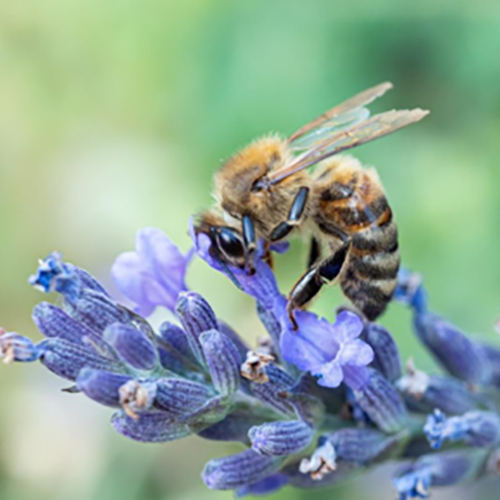Identifying bumble bees:
Key characteristics of bumble bees are their rounded, stout, bodies and their thick fur. They have large, black eyes, a heart-shaped face, four dark wings, and dark antennae that have an elbow-like bend.
Bumble bee species can be differentiated by the pattern of different-colored bands or body segments. Looking at the bee’s back from above and taking note of the color patterns from head to thorax is the most critical factor in identifying a specific species of bumble bee. These segments can be black, brown, buff, yellow, red, orange, or white.
Identifying bumble bees can be quite confusing, since they can look similar to other types of bees and even other insects. Bumble bees are most commonly confused with honey bees, carpenter bees, and flies. See the image below for some key differentiating characteristics to watch out for:
Bumble Bees vs. Honey Bees
Bumble Bee
Bombus occidentalis
Photo by Diane Wilson
Large, wide, and furry
Four dark wings
Build their nests underground in abandoned burrows that allow for safe winter hibernation
Nests are small, consisting of a few hundred bees
Usually docile; they travel alone and do not travel in swarms
Independently store the food they need to sustain themselves through their hibernation inside their exoskeleton
Honey Bee
Apis mellifera
Photo by Mike Moss
Small, slender, and only slightly hairy
Two translucent wings
Set up their hives on higher ground to keep their honey safe from ground predators.
Hives can hold thousands of bees
May sting and are seen traveling in groups often consisting of the queen and her workers.
Do not hibernate; the hive depends on their honey storage from warmer monthsto sustain the colony through the winter
Bumble bee behavior
Bumble bees tend to slowly fly from flower to flower, climbing up the flower stalk if there are multiple flowers on a single plant, and will often buzz against flowers to release the pollen. Bumble bees are docile and will raise a middle leg when threatened. They are very reluctant to sting, only doing so if they are trapped or defending their nest.
Which bumble bees live in Utah?
There are more than 200 species of bumble bees around the world all residing under the genus Bombus. In Utah, there are approximately 17 historically native species. These species include:
B. appositus (white-shouldered bumble bee)
B. balteatus (golden-belted bumble bee)
B. bifarius (two-form bumble bee)
B. centralis (central bumble bee)
B. fervidus (golden northern bumble bee)
B. flavidus (Fernald cuckoo bumble bee)
B. flavifrons (yellow-fronted bumble bee)
B. griseocollis (brown-belted bumble bee)
B. huntii (Hunt's bumble bee)
B. insularis (indiscriminate cuckoo bumble bee)
B. melanopygus (black tail bumble bee)
B. mixtus (mixed bumble bee)
B. morrisoni (Morrison's bumble bee)
B. nevadensis (Nevada bumble bee)
B. occidentalis (western bumble bee)
B. pensylvanicus (American bumble bee, including the Sononran bumble bee: B. p. sonorus)
B. rufocinctus (red-belted bumble bee)
B. sonorus (Sonoran bumble bee)
B. suckleyi (Suckley's cuckoo bumble bee)
B. sylvicola (forest bumble bee)
B. terricola (yellow-banded bumble bee)
For a more in-depth guide to various bumble bee species:



